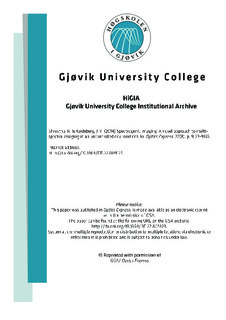Spectrogenic imaging: A novel approach to multispectral imaging in an uncontrolled environment
Journal article
Permanent lenke
http://hdl.handle.net/11250/195038Utgivelsesdato
2014Metadata
Vis full innførselSamlinger
Originalversjon
Shrestha, R. &Hardeberg, J. Y. (2014) Spectrogenic imaging: A novel approach to multispectral imaging in an uncontrolled environment. In: Optics Express, 22(8), p. 9123-9133.Sammendrag
Increasing the number of imaging channels beyond the conventional three has been shown to be beneficial for a wide range of applications. However, it is mostly limited to imaging in a controlled environment, where the capture environment (illuminant) is known a priori. We propose here a novel system and methodology for multispectral imaging in an uncontrolled environment. Two images of a scene, a normal RGB and a filtered RGB are captured. The illuminant under which an image is captured is estimated using a chromagenic based algorithm, and the multispectral system is calibrated automatically using the estimated illuminant. A 6-band multispectral image of a scene is obtained from the two RGB images. The spectral reflectances of the scene are then estimated using an appropriate spectral estimation method. The proposed concept and methodology is generic one, as it is valid in whatever way we acquire the two images of a scene. A system that can acquire two images of a scene can be realized, for instance in two shots using a digital camera and a filter, or in a single shot using a stereo camera, or a custom color filter array design. Simulation experiments using a stereo camera based system confirms the effectiveness of the proposed method. This could be useful in many imaging applications and computer vision
Beskrivelse
This is an Open Access article.
This paper was published in Optics Express and is made available as an electronic reprint with the permission of OSA. The paper can be found at the following URL on the OSA website: http://dx.doi.org/10.1364/OE.22.009123. Systematic or multiple reproduction or distribution to multiple locations via electronic or other means is prohibited and is subject to penalties under law.
